Quincy Mine Hoist
Today, a very big spool. The University of Houston's College of Engineering presents this series about the machines that make our civilization run and about the people whose ingenuity created them.
Here we are, a group from a small cruise ship. We've docked in Houghton, Michigan, in a waterway that slices through Keweenaw Peninsula, making part of it into a Lake Superior island. This is copper country. American copper mining took off here in the mid-19th century. Abandoned mines riddle the land around towns like Hancock, Houghton, and Calumet. Yet more copper still lies under the open farmlands. Hancock was once a shipping port; and maybe, one day, it'll ship copper again.


Hancock, Michigan, as viewed across the Keweenaw Waterway from Houghton, MI
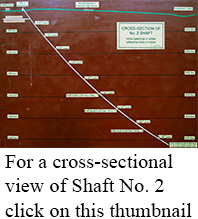 American technology blossomed in the 19th century. Naturally, copper mining took on a new look as it expanded into this remote corner of America. Take the Quincy Mine [just outside of Hancock]: Its No. 2 shaft reaches down at a 55-degree angle from the surface. Horizontal tunnels ran out from that shaft - new ones at each level as the diagonal shaft went deeper and deeper. The deeper it went, the longer the cable that lowered cars, then hauled up copper, rock, and seepage water. It seemed, during WW-I, that the shaft would keep on going much deeper. And they'd need far better means for spooling huge lengths of cable.
American technology blossomed in the 19th century. Naturally, copper mining took on a new look as it expanded into this remote corner of America. Take the Quincy Mine [just outside of Hancock]: Its No. 2 shaft reaches down at a 55-degree angle from the surface. Horizontal tunnels ran out from that shaft - new ones at each level as the diagonal shaft went deeper and deeper. The deeper it went, the longer the cable that lowered cars, then hauled up copper, rock, and seepage water. It seemed, during WW-I, that the shaft would keep on going much deeper. And they'd need far better means for spooling huge lengths of cable.
Does that sound like a side issue - just a big spool? Well, think about a drum holding 2-1/2 miles of 1-5/8 inch diameter steel cable! That cable had to raise and lower carloads of men and material down the main shaft to scores of horizontal tunnels. Since the cars ran a mile and a half into the ground, the cable had to play out rapidly - 36 miles-an-hour.
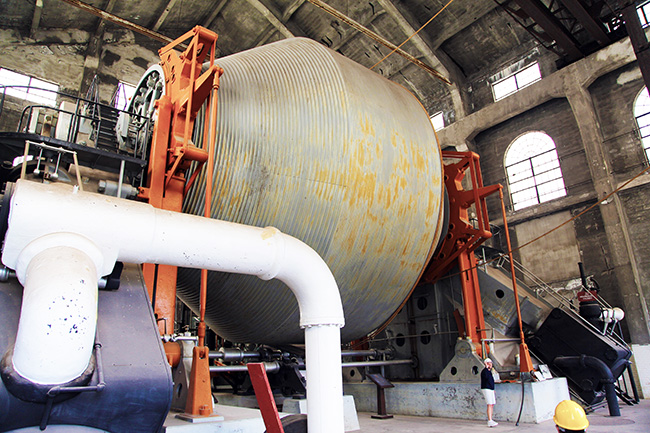
Cable Hoist drum for Shaft No. 2
The cable hoist machinery had grown more elaborate over the years. Now, as the last and most dramatic improvement began, the Quincy Mine people didn't realize this was the twilight of Upper Peninsula copper mining. Copper mining had been moving out west. So work went ahead, and they finished the world's largest hoist in 1920. The spool was a 250-ton, 30-foot-diameter monster - powered by two compound steam engines with cylinders three and five feet in diameter. This was a far better design than the old one had been - bigger, faster, yet more efficient as well. Despite its huge size, it saved 2400 tons of coal in its first year of use.

Cable Hoist drum for Shaft No. 2, seen from the back
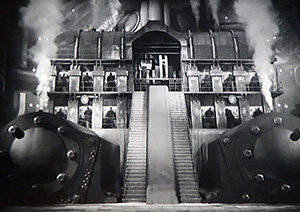 That shaft did go deeper, but not enough to reach the huge drum's capacity. The Mine closed in 1931 and reopened briefly in WW-II. Then this vestigial relic of the steam-powered 19th century went quiet. Now the movie buffs in our small group think about the famous 1927 film Metropolis. Its steam-powered underworld could've been copied from this gargantuan machine.
That shaft did go deeper, but not enough to reach the huge drum's capacity. The Mine closed in 1931 and reopened briefly in WW-II. Then this vestigial relic of the steam-powered 19th century went quiet. Now the movie buffs in our small group think about the famous 1927 film Metropolis. Its steam-powered underworld could've been copied from this gargantuan machine.
I've called this a 19th-century technology, even though it was finished in the 20th. The 19th century was the Romantic era. Things were very grand back then. The engineers provided a machine that did the job superbly. But that machine also made a last glorious design flourish - as it delivered miners from the chilly fields above, into the sweltering ninety-degree underworld a mile-and-a-half below.
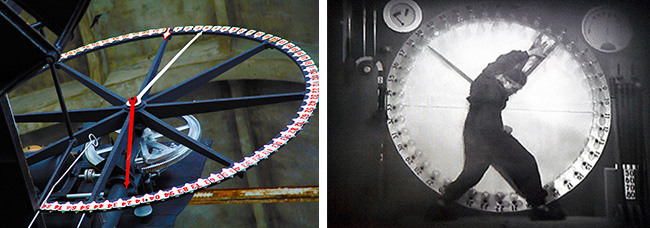
Left: the Quincy Mine depth gage -- the Mine posted a guard to keep the operator from any distraction. Right: a slave laborer managing a dial gage in the movie Metropolis.
I'm John Lienhard at the University of Houston, where we're interested in the way inventive minds work.
(Theme music)
See the Wikipedia page on the Quincy Mine No. 2 Shaft. The American Society of Mechanical Engineers made the hoist a National Historic Engineering Landmark in 1984.
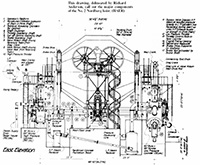 Click on the thumbnail to the right for an engineering drawing of the Quincy Mine No. 2 Shaft Hoist. This drawing is courtesy of the American Society of Mechanical Engineers and taken from the National Historical Landmark document cited above. John Lienhard took all of the color photos during a visit by the Blount small cruise vessel, Grande Mariner, on August 2, 2013. Metropolis stills are TV screenshots and the Keweenaw map is courtesy of the Calumet Visitor's Center Project.
Click on the thumbnail to the right for an engineering drawing of the Quincy Mine No. 2 Shaft Hoist. This drawing is courtesy of the American Society of Mechanical Engineers and taken from the National Historical Landmark document cited above. John Lienhard took all of the color photos during a visit by the Blount small cruise vessel, Grande Mariner, on August 2, 2013. Metropolis stills are TV screenshots and the Keweenaw map is courtesy of the Calumet Visitor's Center Project.
Here is the complete 1927 Fritz Lange Movie Metropolis online. The Quincy Mine Hoist reminded me of it in so many ways. For more on the connection between Metropolis and the heroic construction of the preceding century, see J. H. Lienhard, Inventing Modern: Growing up with X-Rays, Skyscrapers, and Tailfins. (N.Y. Oxford University Press, 2003): Chapter 7.
This episode was first aired on Nov 4, 2013
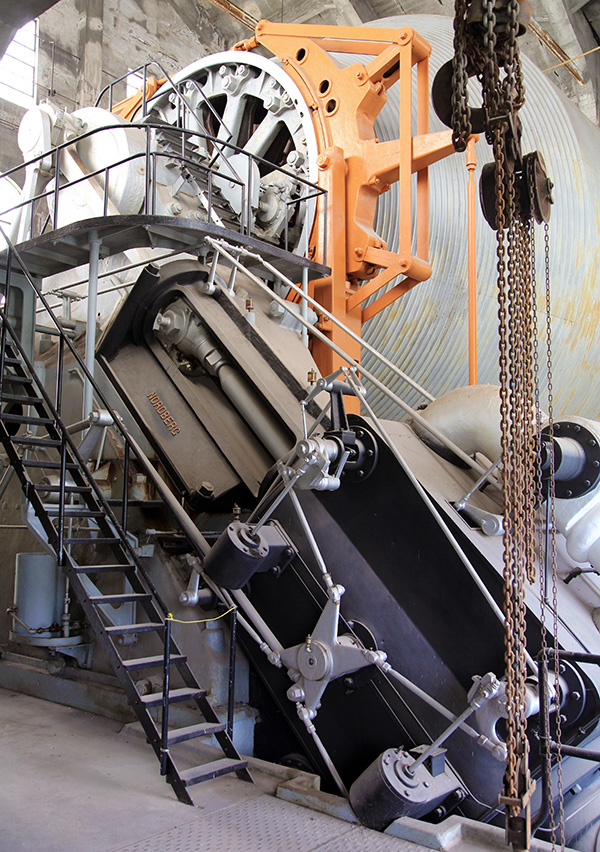
One of two low-pressure cylinders in the drum drive. Steam exhausts into these cylinders from the high-pressure cylinders in these compound engines.